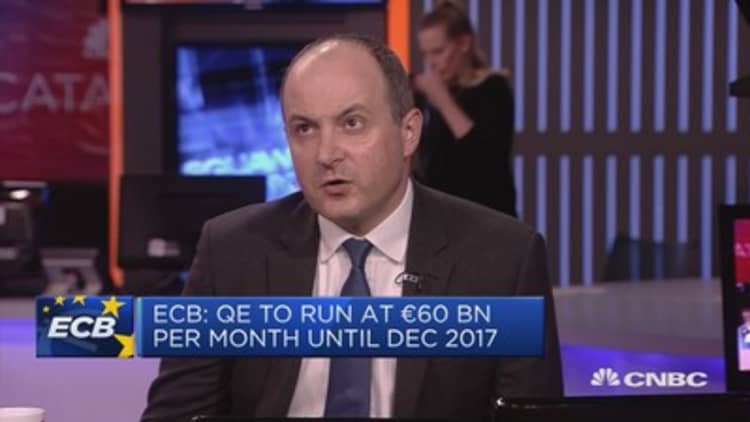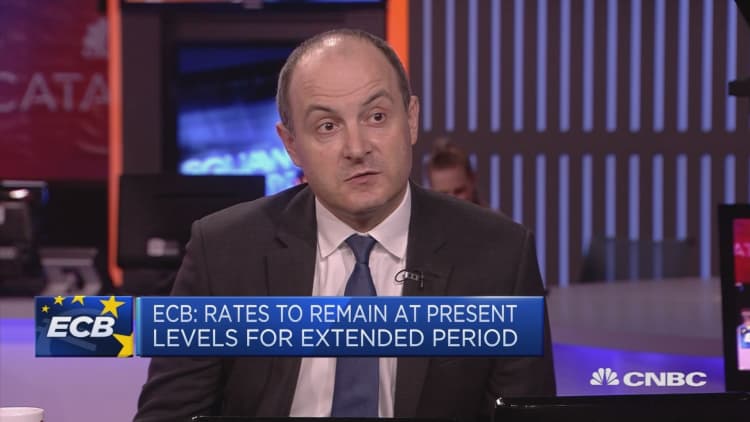The European Central Bank delivered a mixed bag of information for investors at its policy meeting this week, leaving many scratching their heads as to what it's likely to announce at its October get together.
The ECB held interest rates steady on Thursday and said it stands ready to extend its monetary stimulus program as needed. However, this dovish move was countered by President Mario Draghi saying the Governing Council will decide the fate of its quantitative easing program in October — a potentially hawkish move with some expecting it could announce a reduction of its monthly asset purchases.
Central bank watchers will now be waiting eagerly for the ECB's Oct. 26 meeting to find out more. But what can we expect?
An end to the ECB's asset purchasing program?
A core element of the ECB's quantitative easing has been its asset purchase program.
The strategy has seen the central bank purchase government bonds and financial assets in a bid to buoy the economy.
Currently the rate of these purchases is set at 60 billion euros ($72 billion) worth per month. However, the time frame of this program ends in December, and with the economy showing signs of strengthening, many observers have begun to expect a change. This is highly unlikely to result in a complete termination of the program, but rather a gradual tapering.
Economists from Barclays, Deutsche Bank and Pictet agree that asset purchases will be reduced to 35 billion to 40 billion euros worth per month until June. Pictet anticipates that the asset purchase program could be completed by the end of 2018, while Barclays expects the ECB to keep a hold on purchases at around 15 billion to 20 billion euros per month.
The latter said in a research note that "prudent risk management" would prevent the ECB from announcing a full tapering to zero because this could cause another euro rally.
Citi has noted that the ECB could take a more vague approach and reveal only a "2018 envelope" of purchases without specifying a monthly rate. This would give the bank greater flexibility to respond to the appreciating euro and other factors. Citi currently sets this envelope at 150 billion euros worth of purchases for the year, adding that its estimates would be revised up "if financial conditions deteriorate markedly."
Could the ECB increase its asset purchasing?
While the central bank is likely to extend its bond-buying program, an increase of current levels is unlikely given the improving economic conditions. The ECB on Thursday revised up its growth forecast for 2017 from 1.9 percent to 2.2 percent — the strongest forecast yet since the start of the financial crisis.
It could also be impossible, according to some observers, who suggest that the central bank is running out of assets to buy.
Draghi attempted to quash these concerns Thursday by saying the central bank stands "ready to increase our asset purchase program in terms of size and/or duration." He also reiterated that the ECB had coped with the issue of scarcity before by tweaking its eligibility criteria.
Pictet senior economist Frederik Ducrozet noted that the bank was likely to shift its asset bias to account for this.
"Our impression is that the ECB is heading towards a change in QE composition favoring private debt at the expense of sovereign debt purchases as well as a greater use of the program's flexibility in 2018," Ducrozet said in a research note.
What does this mean for interest rates?
Draghi said the ECB expects to keep its key interest rates at present levels "well past the horizon of our net asset purchases."

As such, there should be no change in interest rates in October, and analysts typically agree that current guidance will remain unchanged until 2018.
Barclays has suggested a shift in strategy could be initiated in mid- to late-2018 with a 0.1 percent rise in deposit rates. However, it cautioned that this would be dependent on the euro.
Speaking to CNBC on Friday Valentin Marinov, head of G-10 FX research at Credit Agricole CIB, said the first hike could be more likely in mid-2019.
"Our call for the first rate hike is – I guess the earliest you could hope for that – is mid-2019. That's certainly well after what the market is pricing in at the moment," Marinov said.
Why does the euro matter so much?
The ECB's decision and Draghi's later comments were intentionally dovish to limit the continued appreciation of the euro, according to economists. The currency has risen 13 percent against the U.S. dollar this year, soaring to a 2½-year high Thursday, buoyed by stronger growth forecasts.
A stronger euro is fine if it is in line with real economic growth, but the ECB is worried that it is growing disproportionately and causing inflation to stagnate. The bank revised down its inflation forecasts for 2018 and 2019 as a result — to 1.3 percent and 1.5 percent respectively. This moves it further from reaching its target of close to but below 2 percent. Its 2020 forecast will be revealed in December.

This means that the ECB must be cautious in its approach, and many analysts have tempered their predictions as being dependent on the future path of the euro.
Credit Agricole's Marinov noted that a continued rally could hurt the region, and in particular European exporters. But he insisted that the currency remains "well below" worrying levels of around "$1.25 to $1.27."
Taking example from the Fed
Part of the euro's rise has been due to the dollar's weakness this year on the back of ongoing political upheaval in Washington.
Draghi suggested Thursday that other central banks cannot be ignored if they are likely to impact global financial conditions. As a result, the ECB will be looking to the Federal Reserve's Sept. 19-20 meeting for signals.
"Should the euro appreciate much further in the coming months owing to easier-than-expected Fed policy, the ECB could delay its first deposit rate increase until 2019," Barclays' European economists Philippe Gudin and Antonio Garcia Pascual said in a note.


